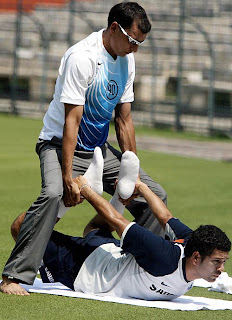Just two weeks after the world cup and this weekend we had so much of international cricket going on. The first test between England and West Indies looked interesting for a while and then faded off to an inevitable draw. Both sides lacked a match winning bowler barring Monty Panesar who showed the value of a quality spinner and even on a flat track managed to trouble the West Indians.
The Indians managed to avenge their World Cup defeat against Bangladesh by winning the ODI series 2-0. However, Bangladesh looked good in the first ODI and India won largely thanks to a match winning innings from Dhoni. The decision to bat Dhoni at number 3 in ODI’s is the right one. He’s an attacking batsman and like all attacking players he too plays best when there is less pressure on him. Looking back at the World Cup it’s hard to imagine why he batted so low down the order. Another one of those failed ploys during Greg Chappell’s tenure. The first test between India and Bangladesh, as I said in my previous post (The Land of Heroes and Comebacks) gave the opportunity for Tendulkar and Ganguly to get amongst the runs. Each of them scored a century on a flat track against a mediocre bowling attack. As the series goes on, these Indian batsmen would look to pile on the runs to ensure their places in the test team are secured and to push for a place in the ODI squad as well. Nothing’s changed in Indian cricket.
The series between Pakistan and Sri Lanka consisted of 3 ODI’s. A tired looking Sri Lankan team lost the series in the end. It’s hard to imagine the purpose of this series. The only reason it took place was because there was a willing sponsor and the Pakistan and Sri Lankan Cricket Board’s wanted to make some money. The mental as well as the physical fatigue on the Sri Lankans were quite evident. They had just played in the World Cup final and after going through a month and a half of cricket in the Caribbean, spend barely a week at home before boarding a plane to Abu Dhabi.
The only positive for the Sri Lankans would be that the series gave an opportunity to blood many of the youngsters. Pakistan of course wanted the series after their early exit from the World Cup. However, is this the right way to go about it? The value of International Cricket is being diluted by playing series’ such as these. The ICC should insist that there should be a reasonable gap between each series a country plays prior to granting “International” status to ODI’s. It’s time that the ICC concentrated on quality rather than quantity. The game needs to spread around the world but this cannot be done overnight. The critics of the World Cup who complained that it was too long had barely finished complaining when this series started.
In addition this week it was announced that India will take on Pakistan at Glasgow on July 3 and Pakistan will play Scotland at Edinburgh two days earlier. In the week before those matches, India play South Africa in three ODIs at Belfast and those games are preceded by Ireland playing back-to-back ODIs against India and South Africa.
In the second week of July, West Indies, Ireland, Netherlands and Scotland play in a quadrangular one-day tournament, again in Belfast.
In early June the Afro-Asia series takes place in Chennai and Bangalore, a time of year when heavy rain is expected.
However, there are increasing signs that the endless schedule of one-day tournaments is leaving broadcasters weary, and there remain doubts whether some of the matches detailed above will attract TV coverage.
Too much ODI Cricket is being played? What do you think ?
